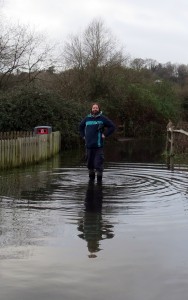Mole and vole saved during high waters

Paul Steven’s weekly Wildlife Sightings column appears in the Chichester Observer, the Littlehampton Gazette, the Bognor Regis Observer, the Shoreham Herald and the Worthing Herald.
Mon 13 Jan: Water levels remained high across the grounds of the WWT Arundel last week. The water threatened to enter the visitor centre building and closed the reserve to visitors entirely for two days. Despite less rainfall and lower tides last week water continuously trickled through the chalk hills of the South Downs, keeping levels high throughout the Arun valley and fields near the town of Arundel.
The visible wader population at Arundel plummeted during the flooding. It became too deep for the grey herons to fish here plus they had many flooded shallow areas in the valley to choose from. With water levels returning to normal the herons have been coming back. The snipe population moved to areas of high ground in the reedbed and remained onsite during the flooding.
Our 50+ winter shoveler duck population left the reserve and spread throughout the valley, again spoiled for choice in feeding spots with all the water around. Cormorants loved the high water here and visited regularly to fish. This morning Sam counted over 300 teal from the hides and 37 shelducks. She also spotted 40 gadwall this morning, well over the 12-16 that usually visit.
Kingfishers and other smaller birds were unaffected by the water levels – Sam had three kingfisher sightings this morning at Wetlands Discovery, Ramsar hide and Scrape hide. Eleven lapwings have returned to the waters near the Sand Martin hide this morning.
Small animals on the reserve struggled during the flooding. The waters rose gradually, hopefully allowing them a chance to move out of the way. Staff saw water voles heading for higher ground at the back of the reedbeds. Sam came to the rescue of a water vole that lives in the ditch by our Pond Skaters play area. The area had been surrounded by netted fencing to stop wild geese destroying the mud bank where the water vole feeds. Sam found the water vole clinging to the netting and cut the fencing to allow him to swim free.
Before and during the flooding the weather was quite mild. We hope the warmer weather meant that hibernating dormice were only be in light torpor and were easily awoken by the rising waters near their nests in the hedgerows. Water and warm temperatures also forced insects and butterflies from their winter sleeping spots. Staff spotted active red admiral butterflies and wasps flying around the reserve.
Sam and I found a young mole swimming along what was the works access road behind Wetland Discovery. The mole bumped into a rotting tree and began to burrow inside. Sam rescued him and we took him to higher ground where he immediately burrowed into the earth.
